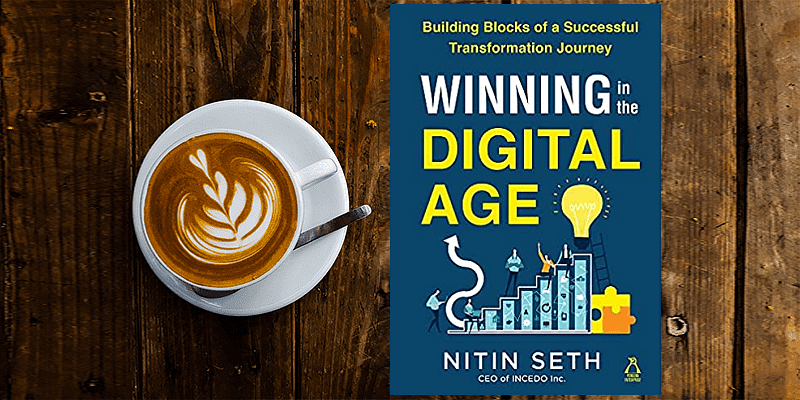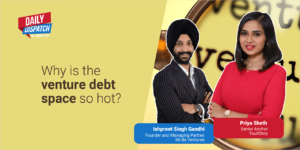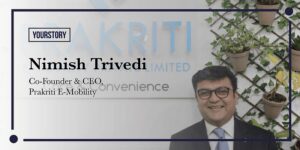Launched in 2012, YourStory’s Book Review section features over 315 titles on creativity, innovation, entrepreneurship, and digital transformation. See also our related columns The Turning Point, Techie Tuesdays, and Storybites.
Drivers, trends, and implementation of digital transformation are well captured in the book, Winning in the Digital Age: The Seven Building Blocks of Successful Digital Transformation by Nitin Seth.
Digital makes possible speed, accuracy, productivity, innovation, and convenience. Successful digital transformation calls for changes at the level of tech stack, organisational culture, operational processes, and leadership mandates.
Nitin Seth is CEO of tech services form Incedo, and was earlier COO at Flipkart, MD for Fidelity International in India, and Director of McKinsey’s Global Knowledge Centre. In the dotcom years, he was also founder of the startup ActiveKarma. The book thus provides a unique blend of perspectives from the author’s 25-year journey as a founder, intrapreneur, MNC consultant, and CEO.
The book is written from a practitioner point of view, with plenty of checklists and tips in around 50 chapters. But surprisingly, the book has no index, and there is no bibliography of related books. Some of the material comes across as repetitive across the chapters as well.
Here are my key takeaways from the hefty 510-page book, summarised as well in the table below. See also my reviews of the related books Dual Transformation, Future Tech, Innovation Ultimatum, Seeing Digital, Out-Innovate, From Incremental to Exponential, The Next Billion Users, and Machine, Platform, Crowd.
1. New rules of business
Customer expectations have increased, and real-time personalisation, convenience, value, and transparency are the norm, as offered by the FAANG giants and nimble digital startups. Product and business lifecycles are shrinking, and the VUCA world calls for continuous learning, experimentation, and reinvention (even at the cost of some cannibalisation).
Digital transformation calls for end-to-end change, with iterative feedback loops between strategy and execution, Nitin observes. Customer relationships need to become more co-creative, along with open innovation platforms and a web of partnerships,
Every company needs to build a tech DNA, and digital transformation needs to involve the CEO, CIO, CTO, and CMO (some even have a Chief Digital Officer). A cross-functional structure is needed to support a range of product offerings, with product managers playing the role of integrators connecting customer, business, and tech insights.
Harnessing data holds the key to better customer engagement and internal operations. But many companies run the risk of creating a “data quicksand” or “murky swamp” if they don’t leverage it effectively, Nitin cautions.
“Two-speed execution is critical,” he explains, with a mix of speedy short-term execution and long-term bets. “Managing this duality across levels is essential to success in the digital age,” he adds.
Business models need to be reinvented, and the operating model should embrace “aligned autonomy.” Data infrastructure should be capable of handling big data, real-time transactions, agile adaptation, and rapid experimentation. The mindset of “getting it right the first time” may not work, Nitin cautions.
2. Sectoral transformations
Observing patterns from digital impacts across sectors yields useful patterns for insights and foresights. The author analyses transformations in six industries in this regard.
Fintechs have brought payments (now impacting B2B transactions as well) to the forefront of digital transformation, while life sciences are moving from laggard position to tipping point. OTT players have been leading the content game, but 5G offers telcos a breakthrough opportunity via IoT solutions and network slicing.
Banks have been attacked by digital natives, and continue to have a “control mindset” – they need to work more on data harmonisation and customer-centric design. Automation and advisor enablement are transforming wealth management, but concerns remain over cybersecurity, Nitin observes.
Enterprise products are being transformed by cloud-led “SaaS-ification”, with lots of potential via global delivery. Across these sectors, digital impacts are in data assets, disintermediation, omni-channel operation, automation, customer stickiness, personalisation, pandemic resilience, and regulatory transformation.
3. Tech building blocks
The author identifies seven key building blocks of the tech stack, moving outside-in: customer experience design, analytics, automation, AI, data infrastructure, blockchain, and cloud.
“The most important aspect of these digital technologies is that they are not independent but are interconnected,” Nitin observes. Rapid and seamless customer experience requires process redesign via automation and process improvement via AI self-learning.
“Cloud is increasingly becoming the backbone of the technology stack,” Nitin affirms. It enables infrastructure scaling, varying cost, enhancing AI, and improving enterprise data – which ultimately reduces time to market, enhances customer experience, and facilitates new business models.
The author distinguishes between different types of analytics: descriptive, predictive, prescriptive, continuous (as compared to batch), and augmented (with AI/ML). “Analytics projects are messy, complicated and iterative,” he cautions. Tech skills will need to be blended with domain and problem-solving skills as well.
“While Amazon may have had the advantage of starting as a digital-native business, Walmart and Home Depot have successfully managed to integrate both their physical and digital channels to tremendous competitive advantage,” Nitin says.
“Process mining has emerged as a key technology lever in business process transformation,” he adds. Decision-makers are augmenting their intuition and experience with machine-enabled recommendations (“augmented intelligence”).
Digital is helping with diagnostics, optimisation, risk management, and workflow re-design. Superior data governance, architecture agility, and API-driven insights are key enablers.
“Blockchain is a nascent technology but one with tremendous potential, given its promise to enhance trust in both record keeping and transactions,” Nitin observes. Other technologies on the rise include VR/AR and voice interfaces.
Tech decisions to make include build, buy or subscribe, as well as joint ownership by business and IT heads. “The need and urgency for reliable digital solutions have never been as compelling as in the post-COVID world,” Nitin affirms.
4. Global delivery
This section of the book addresses the digital opportunity for the IT/ITeS sectors in emerging economies like India. “The ability to increase innovation capacity leveraging the global delivery model is a great opportunity for enterprises in the digital age,” Nitin emphasises.
Instead of just cost, execution and support centres, global delivery centres (captive or outsourced) can become hubs for revenue, innovation, and competitive advantage. Nitin cites his experience with the McKinsey Knowledge Centre in India as an example of delivering analytics capabilities globally.
This requires a mindset change, different operating model, better talent profiles, entrepreneurial leaders, and global-local partnerships. India is well positioned in this regard due to the size and youth dividend of its talent pool.
Managers need to get out of the “comfort zone” of existing back-office arrangements, and step up their creative and entrepreneurial quotient. The younger workforce is more confident in this regard, Nitin observes. He urges managers to invest in new and varied experiences of their own to develop a global mindset.
5. Organisational change
“Organisational culture is probably the most important enabler of digital transformation,” Nitin explains. Cultural capabilities should be built in seven areas: learning, knowledge management (KM), agility, innovation, diversity, change management, and future of work.
“Audacity is a critical success factor,” Nitin explains, drawing on the experience of Flipkart during its phase of rapid growth. “Risk-taking is essential but it has to be intelligent risk-taking and not just playing the casino,” he cautions.
“In the digital age, every enterprise has to be a knowledge company,” he affirms. High-quality, contextual and proprietary knowledge is a key differentiator, and requires leadership sponsorship, knowledge architecture, and a culture of sharing and collaboration.
Nitin classifies KM levers into two types: strategic (leadership commitment, culture, design) and operational (architecture, processes, tech). KM enablers include incentives, success stories, KPIs, knowledge maps, editorial roles, taxonomy, and search tools.
“The biggest challenge to learning is hubris, that you know it all and/or I know best,” Nitin warns. Humility is the antidote.
The L&D function should enable personalised, self-directed, byte-sized, and group social learning, and improve its own talent DNA. Multi-skilling and future-skilling are the need of the hour, which includes empathy, contextual intelligence, and problem-solving skills. The future of work calls for increased human-machine collaboration as well.
The quantum and quality of enterprise innovation can be improved via collaboration with startups, acquisition of specialty firms, and academic partnerships. This can increase the innovation quotient beyond incremental steps. Nitin recommends that the culture should be one of “aligned automomy”, with a safe space to experiment, make mistakes, and learn from them.
Agile approaches for “fail fast and learn fast” help cope with a fast-changing world. Customer proximity and collaboration help build trust, and actual execution rather than just planning is a source of learning.
6. Leadership principles
Professionals need to shift their thinking from being managers to being entrepreneurial leaders. The author defines the “5 Cs” of successful leadership as cause, care, courage, communication, and character.
“Leadership is about finding your own personal style,” Nitin advises. “Leadership is a journey,” he adds, and leadership emerges with the choices, challenges and responsibilities one faces.
Nitin provides a range of tips in this regard: solve rather than complain, stretch yourself, give before getting, do the right thing rather than the easy thing, and focus on larger goals rather than personal ones.
One outstanding chapter addresses the 16 contradictions or dualities leaders face in the digital age. They include growth/profitability, short/long term, customer/employee, sales/delivery, quality/speed, data/intuition, product/service, plan/do, autonomy/control, intellect/emotion, and even spirituality/materialism.
Leaders need to focus on their customers, employees, society, and the environment as well. This impacts them at the individual and organisational level, eg. in terms of “good growth” and “bad growth.”
7. The next generation
The concluding section focuses on the unique opportunities for youth, and how to find the sweet spot of success with passion, talent, and purpose. Digital natives are more intuitively able to understand new technologies and how new business models can be built using them, Nitin observes.
“Leadership is not about a position assigned to you, but about the responsibilities you take on proactively,” he advises. Youth should build their hard and soft skills across disciplines, cultivate long-lasting relationships and explore entrepreneurship with a sense of purpose.
“Technology disruption is creating unprecedented new opportunities,” Nitin observes. Countries like India have a supportive startup ecosystem that lets entrepreneurs think big and take risks. Stories of MakeMyTrip, Ola, Paytm, and Flipkart are exemplary in this regard.
“Success is about discovering and realising your full potential,” he suggests. “One of the negative consequences of success is arrogance,” Nitin cautions. Humility, grounded circles, and ethics can be corrective factors.
Two chapters share leadership lessons from Steve Jobs (eg. intersection of engineering and arts, simplicity, conviction, design, focus, resilience) and even the giant sequoia trees (eg. natural strength, scale from seed, community support).
Another chapter shares practical business frameworks and principles like risk-return tradeoffs, 80-20 rule, urgent/important matrix, and industry S-curves. Trust is defined as a combination of credibility, reliability, intimacy, and focus beyond just the self.
The road ahead
In sum, the rapidly changing digital age calls for new approaches to individual creativity, tech mastery, organisational design, and leadership mandates.
Digital is an equaliser and provides a level playing field for new ideas, talented teams, and perseverance. Toggling and aligning short-term (specific problems, quick wins) and long-term actions (bigger strategic bets) help in the transformation journey.
“When change is inevitable, you might as well set your sights high. Play to win, not just to survive,” Nitin signs off.
YourStory has also published the pocketbook ‘Proverbs and Quotes for Entrepreneurs: A World of Inspiration for Startups’ as a creative and motivational guide for innovators (downloadable as apps here: Apple, Android).


![Read more about the article [Funding alert] Invest-tech platform dezerv. raises $7M co-led by Elevation Capital and Matrix Partners India](https://blog.digitalsevaa.com/wp-content/uploads/2021/08/Image6xbm-1599641408155-1630309241895-300x150.jpg)







